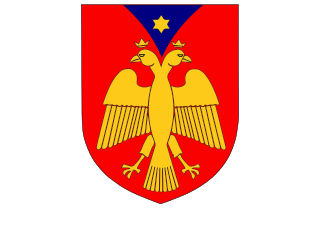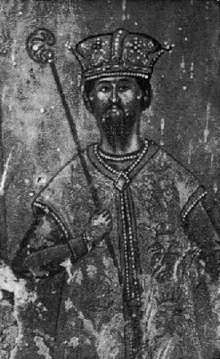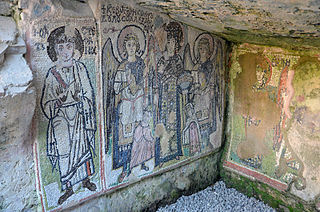The League of Lezhë was a military alliance of Albanian feudal lords forged in Lezhë on 2 March 1444, with Skanderbeg as leader of the regional Albanian and Serbian chieftains united against the Ottoman Empire.
Balša Balšić, known in historiography as Balša II, was the Lord of Lower Zeta from 1378 to 1385. He managed to expand his borders towards the south; defeating the Albanian duke Karl Thopia.
George Thopia was the Lord of Durazzo (Durrës) from 1388 to 1392. He was the son of Karl Topia and Vojislava Balšić. George married Voislava (Teodora), the daughter of sevastokrator Branko Mladenović, of the Serbian Branković family.

The Battle of Savra or the Battle of the Vjosë was fought on 18 September 1385 between Ottoman and much smaller Zetan forces, at the Savra field near Lushnjë. The Ottomans were invited by Karlo Thopia to support him in his feud against Balša II.
Konstantin Balšić, was a lord of the Balšić family, who ruled over lands in northern Albania.

Principality of Albania (1368–1392) was an Albanian principality formed after the disestablishment of Kingdom of Albania, by Karl Thopia. The principality changed hands between the Thopia dynasty and the Balšić dynasty, until 1392, when Durrës was annexed by the Republic of Venice.

The Muzaka were an Albanian noble family that ruled over the region of Myzeqe in the Late Middle Ages. The Muzaka are also referred to by some authors as a tribe or a clan. The earliest historical document that mention Muzaka family is written in 1090 by the Byzantine historian Anna Komnene. At the end of the 13th and beginning of the 14th century members of the Muzaka family controlled a region between the rivers of Devoll and Vjosë. Some of them were loyal to the Byzantine Empire while some of them allied with Charles of Anjou who gave them impressive Byzantine-like titles in order to subdue them more easily. During a short period, Serbian Emperor Stefan Dušan occupied Albania including domains of Muzaka family but after Dušan's death they regained their former possessions. After the Battle of Savra in 1385 the territory of Albania came under the Ottoman Empire; they served the Ottomans until 1444 when Theodor Corona Musachi joined Skanderbeg's rebellion. When the Ottomans suppressed Skanderbeg's rebellion and captured the territory of Venetian Albania in the 15th century many members of the Muzaka family retreated to Italy. Those who stayed in Ottoman Albania lost their feudal rights, some converted to Islam and achieved high ranks in the Ottoman military and administrative hierarchy.
Saint Gjon Vladimir's Church is a church in Shijon, Elbasan County, Albania. It is dedicated to the Dukljan prince and saint Jovan Vladimir, the son-in-law of the Bulgarian Tsar Samuil. It became a Cultural Monument of Albania in 1948. The first temple is the oldest large Orthodox basilica from the times of Tsar Samuil, rebuilt as present church by the Thopia family in 1381. During the 18th century Kostandin Shpataraku painted the walls of the church.

The Sanjak of Albania was a second-level administrative unit (sanjak) of the Ottoman Empire, located in what is today central and southern Albania. Its territory stretched between Krujë in the north and Kalamas river in the south. It was established in 1415–17, and was disestablished in 1466 with the establishment of the Sanjak of Elbasan.

Thopia family was one of the most powerful Albanian feudal families in the Late Middle Ages. It was initially part of the nobility of the Angevin Kingdom of Albania.
Niketa Thopia was the Lord of Krujë between 1392—1394 and 1403—1415. He was a member of the Thopia family and the son of Karl Topia, the Prince of Albania.
Helena Thopia was an Albanian princess of the Thopia family who held the Krujë region as sovereign lady for two terms; 1388-1392 and 1394-1403.
Pal Dukagjini or Paul Ducagin was an Albanian nobleman, a member of the Dukagjini family. He and his kinsman Nicholas Dukagjini were initially subjects of Lekë Zaharia, a Venetian vassal who had possessions around Shkoder. Nicholas murdered Lekë, and the Dukagjini continued to rule over their villages under Venetian vassalage. Pal and Nicholas were part of the League of Lezhë, a military alliance that sought liberation of Albania from the Ottoman Empire, founded by the powerful Skanderbeg. In 1454, the Dukagjini accepted vassalage of Alfonso V of Aragon, as other chieftains had done three years earlier. Pal later abandoned Skanderbeg's army and deserted to the Ottomans.
Gojko Balšić and his brothers George Strez and John were the lords of Misia, a coastal area from the White Drin towards the Adriatic. The brothers were members of the Serbian noble house of Balšić, which earlier held the Lordship of Zeta. They participated in founding the League of Lezhë, an alliance led by their maternal uncle Skanderbeg. Gojko supported Skanderbeg until the latter's death in 1468, and then continued to fight against the Ottomans within Venetian forces.
Ivan Strez Balšić and his brothers George Strez and Gojko Balšić were the lords of Misia, a coastal area from the White Drin towards the Adriatic. The brothers were members of the Balšić family, which earlier held Zeta, but had now placed itself among the nobility in Albania. They participated in founding of the League of Lezhë, an alliance led by their maternal uncle Skanderbeg. Ivan and Gojko supported Skanderbeg until he died in 1468 and then continued to fight against Ottomans together with Venetian forces. After Skanderbeg's death Venice installed Ivan Strez Balšić as Skanderbeg's successor.
Andrea Thopia or Andrew Thopia was 15th century noble man from Albania whose domains included the territory of Scuria. He was a member of the Thopia family and one of the founders of the League of Lezhë.
Komnen Arianiti was an Albanian nobleman of the Arianiti family, who held an area in central Albania around Durrës. His son Gjergj became a prominent leader of the Ottoman-Albanian wars.
Marco Barbarigo was a Venetian nobleman, who married Helena Thopia and thus inherited the rule of Croia (Krujë), which he initially held under Venetian and later, after quarrelling with Venetian noblemen, Ottoman suzerainty, until in late 1394 when he was defeated by Venetian subject Niketa Thopia and forced into exile at the court of Đurađ II Balšić. He was appointed the Venetian governor of Cattaro (Kotor) in ca. 1422.














